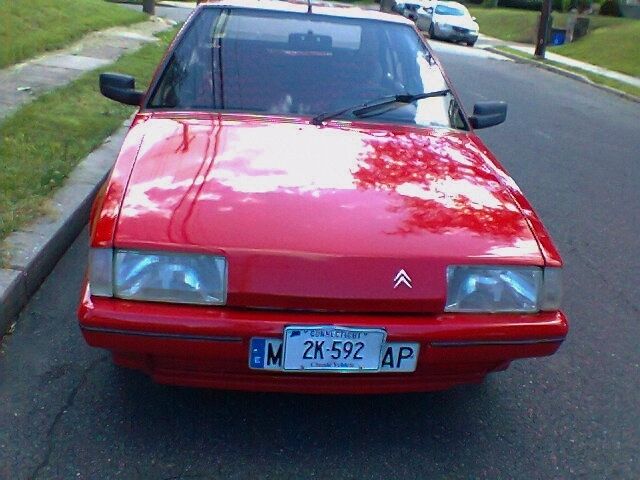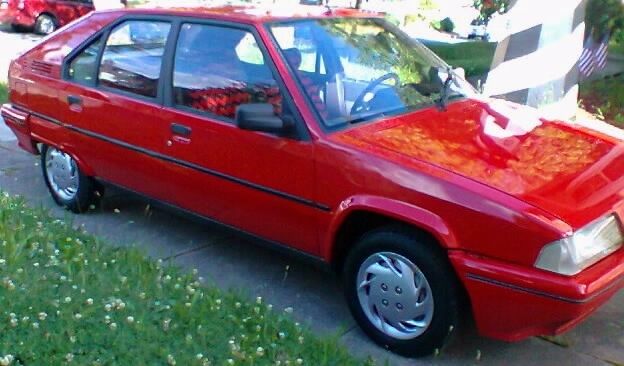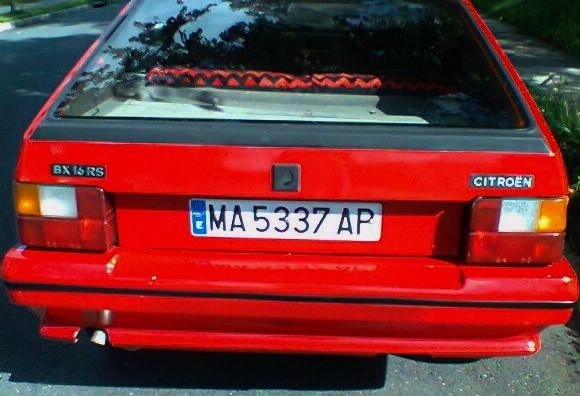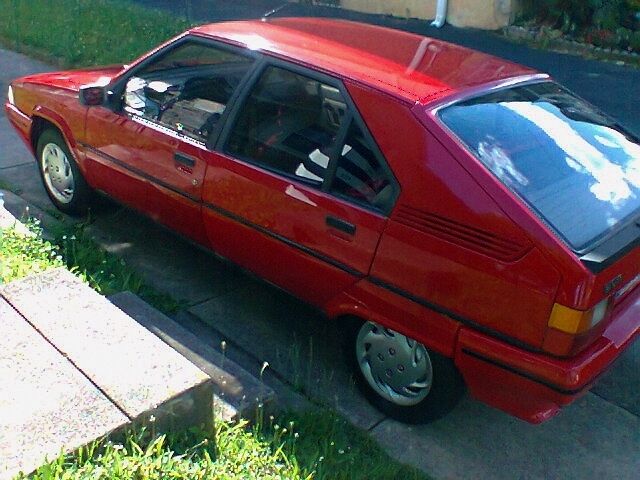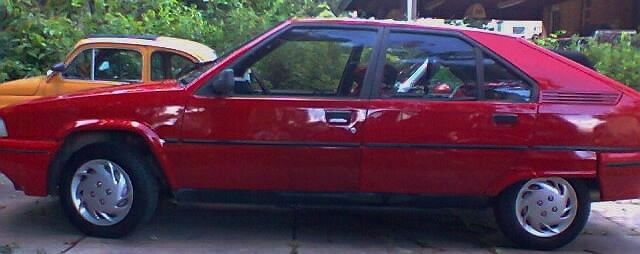Citroen BX16 RS NO RESERVE!!!
- Price:
- Location: Upper Darby, Pennsylvania, United States
- Condition: Used
- Make: Citroën
- Model: BX16RS
- Type: Sedan
- Trim: Cloth
- Year: 1980
- Mileage: 79080
- VIN: VS7XBXB0040XB2696
- Color: Red
- Engine size: 1.6
- Number of cylinders: 4
- Power options: Air Conditioning, Power Locks, Power Windows
- Transmission: Manual
- Drive type: FWD
- Interior color: Gray
- Options: CD Player
- Vehicle Title: Clear
1980 Citroën BX16RS Description
NO RESERVE!!! Up for sale is this extremely rare (well rare in the U.S. anyway) 1989 Citroen BX16 RS. This car is a two owner low mileage (114392 kilometers or 71,089 miles). This example was brought over at considerable expense from southern Spain and was purchased there from its original owner, a retired school teacher, who used it as her daily driver. 1.6 L 4 cylinder, Five Speed, power front windows (rear are manual roll down) power locks, Quartz clock (which actually works!), A/C (needs a charge but complete with compressor etc. functioning) AM/FM /CD with bluetooth and auxillary input. Carburetor model (choke needs some tinkering) and the world famous Citroen multi level hydro liquid 3 level suspension which goes up and down in seconds with the lever/switch shown in pictures. New spheres and octopus tubing. Rides like floating on a cloud with self leveling, yet agile and nimble with good acceleration and cornering. Runs excellent, uses no oil, smooth quiet engine. Cloth interior is clean comfortable and retains the original covers underneath the dressed up chevron style covers as shown. Carpet good with no wear or stains. Large cargo area hatch. All glass is good no chips or cracks. Body excellent with ZERO rust or dents (many composite panels were used when manufactured) and was repainted from it's original white to a fire engine red (it was hard to get good pictures since the reflection was so brilliant). Tires have good tread but very old and should be replaced (has a couple low spots and some vibration at high speed). Newer exhaust and muffler. Only needs a new instrument cluster casing as the original was cracked and broken. I placed some carbon fiber laminate to improve the appearance for now until replacement.The car has cleared custom and EPA requirements and as a 25 year old car is exempt from emissions. It is insured and registered as an antique in the State of Connecticut. Please note Connecticut does NOT issue title for cars 20 years or older and will be sold with a Notarized Bill of Sale and Registration.
Some extra parts included including a headlight and radiator along with some receipts and customs documents.
We are close to all major transportation and local buyers are welcome to drive and inspect. The car is also for sale locally and seller may end auction at any time. Buyer responsible for shipping but will assist in any way possible. Feel free to email any questions. Thanks for looking and good luck!
Finally a little bit of history:
The Best of Both Worlds
After years of losing money, Michelin - the owner of Citroen - withdrew in 1974. Citroen fell into the hands of its arch-rival Peugeot. The conservative new owner started rationalizing Citroen, eliminating excessive technologies and sharing components with its own models. This eventually brought Citroen back into black, but it also killed the individual character of Citroen.
BX was launched during this transitional period. However, compare with later CitroenAfter s it preserved most of the unique character, while compare with older Citroens it was far more reliable and practical to own. Combining the best of the two worlds, BX was probably the best Citroen since 2CV.
BX was unique in many ways. First of all, its Bertone design, penned by the famous Marcello Gandini (Lamborghini Countach, Lancia Stratos, first gen BMW series 5), looked like no other cars around. It lacked the oddity of traditional Citroen, replaced by a striking angular shape yet achieved a wonderful drag coefficient of 0.34. Best of all, this design remains timeless today, while contemporary family sedans like Ford Sierra, Renault 21 and Peugeot 405 feel far more outdated.
BX brilliantly avoided the two traditional weaknesses of Citroen, namely, overweight and rust problem, by using composite and plastic body panels extensively. The glass-fiber reinforced plastic composites included the bonnet, the tailgate and the roof, while the bumpers and fuel tank were made of plastics, the transparent quarter panels were polycarbonate. Therefore the BX was very lightweight (e.g. 960 kg for a typical 1.6-litre BX) and quick on its feet.
Its packaging was also worth praising. A compact exterior dimensions enclosed a long wheelbase and a somewhat "cab-forward" proportion to enable vast of headroom and legroom for all passengers. The cockpit had a futuristic digital instrument panel. All controls were concentrated within a finger distance from the steering wheel, very aircraft like.
When the BX launched in 1982, fans of Citroen must be delighted it continued to use the independent hydro-pneumatic suspensions. A sphere containing gas and liquid at each corner provided springing and damping. Their setting was stiffer than Citroens of the past, thus gave better roll resistance to please keener drivers. Low speed ride suffered a little, but at high speed the ride quality still marked it out from other cars. The self-leveling function kept ride height unchanged regardless of load. It also raised or lowered the car automatically in relationship to speed, or adjusted by the driver. Besides, the hydraulic system got simpler and more reliable. These continue improvement made the BX far more livable than previous Citroens. BX also tackled another traditional weakness of Citroen - engines. It was benefited by the much better SOHC engines from Peugeot. The most popular were the 93hp 1.6-litre.
The lovely BX lived until 1993. Some 2.33 million units were sold in 11 years, bringing Citroen the greatest success since the days of 2CV. It was replaced by Xantia and then C5, both had lost its charm somewhat and failed to match its sales success.
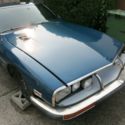 CITROEN SM 1972 CITROEN SM COMPLETE CITROEN GOOD SOLID PROJECT .
CITROEN SM 1972 CITROEN SM COMPLETE CITROEN GOOD SOLID PROJECT .
Mileage: 70000
 Citroen HY Market Van ,Citroen HY,Catering Van,Food Vending Van,Citroen H Van
Citroen HY Market Van ,Citroen HY,Catering Van,Food Vending Van,Citroen H Van
Mileage: 46,000
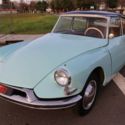 Citroen ID19 1961 No Rust California Car / Citroen DS 19,20,21,23
Citroen ID19 1961 No Rust California Car / Citroen DS 19,20,21,23
Mileage: 121630
 Citroen 2CV No Reserve
Citroen 2CV No Reserve
Mileage: 50,000
 1991 Citroen XM NO RESERVE!
1991 Citroen XM NO RESERVE!
Mileage: 149600
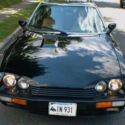 Citroen CXA Prestige (Limo) NO RESERVE!!!
Citroen CXA Prestige (Limo) NO RESERVE!!!
Mileage: 68,556
 1957 Citroen 2CV No Reserve runs
1957 Citroen 2CV No Reserve runs
Mileage: 61,050
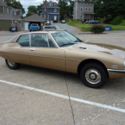 classic cars Citroen - no reserve
classic cars Citroen - no reserve
Mileage: 81,000
 citroen 2cv acadiane 1985 BOSTON CELTICS no reserve !!!
citroen 2cv acadiane 1985 BOSTON CELTICS no reserve !!!
Mileage: 89,775
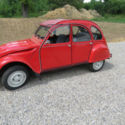 1970 Citroen 2CV6 Club RESERVE LOWERED
1970 Citroen 2CV6 Club RESERVE LOWERED



